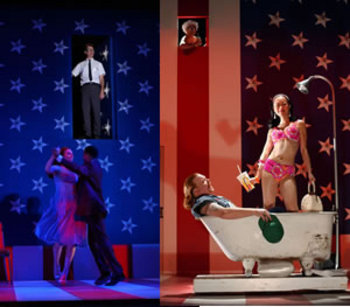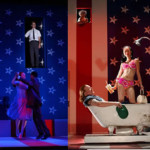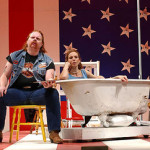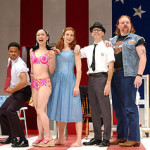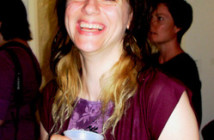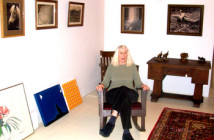It may or may not make a difference to know the collage and assemblage based work of the leading Pop artist, Robert Rauschenberg, prior to experiencing this fast paced revue of sketches written by Charles L. Mee, and directed by Anne Bogart, which opens the season for the American Repertory Theatre of Harvard University in Cambridge, Mass.
As we await the beginning of the play there is a large L shaped drop cloth that covers a wall taking up about a third of the back of stage allowing us to see the bare wings. This generic cloth cascades down and forward to the edge of the stage. A couple of stage hands arrive and pull down the cover, remove it, and reveal a backdrop of a big pop American flag, with large light bulbs screwed into the stars. The stripes are painted onto the stage floor. The set by James Schuette allows for a house façade with door and upper level windows, as well as moments when it becomes a Star Spangled Banner in every sense. Moments later a motley crew of characters emerge and cavort about from a bum in a box, a cheerleader with a shirt that says USA on roller skates, a slim Asian woman in a bright two piece bathing suit, a biker, Bob’s Mom in a house dress and apron looking very 50s, a straight black man in suit and tie and his similarly straight girl friend/fiancé, a slim salesman type with a generic doofus hat, his boyfriend, later a Pizza guy and a kid in kilts playing bagpipes. I think I got them all.
While we are sorting out the identity and personas of these characters or caricatures of vintage, small town, rural Americana we focus on the Rauschenbergian props. There is a bath tub and attached shower which is used effectively in a number of the subsequent vignettes, also a small deer with some kind of fluffy ring about its rear, arguably a reference to the artist’s famous Angora goat with a tire in a similar place, a kind of stuffed rooster prop, and an interesting use of a tire that transforms from prop to swing for the girl in a bathing suit.
The only direct connection to the artist, his life and work comes from the nostalgic memories of his Mom. She narrates slides projected on the backdrop but the specific images, taken from family albums, do not in any way connect to her dialogue. She appears to be locked into her own reveries as a signifier of rural America the Port Chester, Texas town where the artist grew up. She grounds the Mom and Apple Pie content of the artist’s mature work and his running satire and critique of American consumerism. She is the protagonist for a couple of the “events” in the course of the evening, a picnic, to which she brings out platter after platter of tinfoil wrapped food for the table-chicken, corn, and apple cobbler- as well as an assortment of objects for a yard sale.
Much of the success of the play is conveyed by the fast pace of Bogart’s direction and ironic humor. Some skits are funny and work, but others, less so. The best moments occur when the entire ensemble is caught up in sweating to the oldies or romping through a down home country square dance. It is more difficult to get to know or particularly care for any of the individual characters or sub plots. At the end of a lively ensemble dance scene a man gets shot and is held in the arms of his lover. During this poignant moment the biker reels off a bunch of chicken jokes. The gay couple had aspired to set up a chicken farm and there were references as to whether, like Frank Purdue, they will grow to resemble their birds. At some point that results in a character dressed as a chicken slowly making its way across the stage.
You understand that this is a collage of elements that may or may not connect with some other higher meaning. It’s best to surrender to the fun and energy and just go with the inventive high energy flow. But that means that the audience has to be locked and loaded for the latest non sequitor bit that starts to wear and make one wonder about when the end is coming; hopefully sooner rather than later. Now and then we are snapped out of growing apathy by a particularly clever moment. One of these occurs when the Asian bathing beauty, whose heavily accented lines are hard to follow, comes on stage and proceeds to spread out a large plastic drop cloth. She fetches a large bottle of gin which is poured onto the tarp. Moments later she returns with Vermouth and splashes just a bit, followed by a basket of olives. Finally she dives headlong and “mixes” a martini. She is joined by the biker in bathing trunks and knee pads. They roll and frolic about “drinking” the martini. Just as cleverly the tarp is rolled up and dumped in the bathtub as the actors exit to dry up and return for later scenes.
There were several of these wonderful over the top moments. Another occurred at the end when Mom stepped out of character and engaged in an outrageous erotic disco dance. Yes, there were terrific moments but as with the artist’s works you were left separating brilliant collages from sequences that were just cut and paste.
Links:
The American Repertory Theatre
bobrauschenbergamerica
By Charles L. Mee
Directed by Anne Bogart, created and performed by SITI Company. Set and costume design by James Schuette, Lignting design by Brian H. Scott, Sound by Darron L. West, Choreography by Barney O’Hanlon, properties design by Jason Szella, dramaturg Tanya Palmer. Cast: Bob’s Mom, Kelly Maurer, Susan. Ellen Lauren or Rebecca Henderson, Phil’s Girl, Akiko Alzawa, Becker, J. Ed. Araiza. Allen, Stephen Webber or Will Bond, Carl, Barney O’Hanlon, Wilson, Danyon Davis, Bob the pizza boy, Tom Nelis or Daniel Parker, Roller Girl, Jennifer Taher. One act, running time one hour forty five minutes.
American Repertory Theatre
Cambridge, Mass.
September 9 through October 7
All images are courtesy of the ART.

